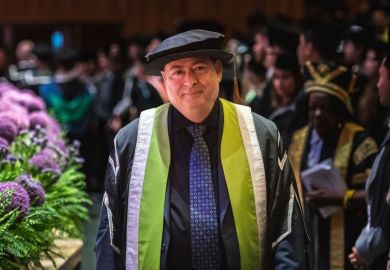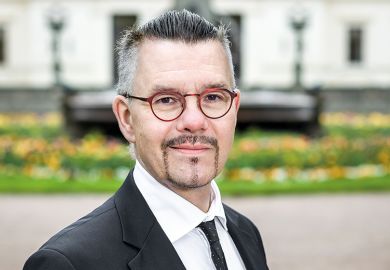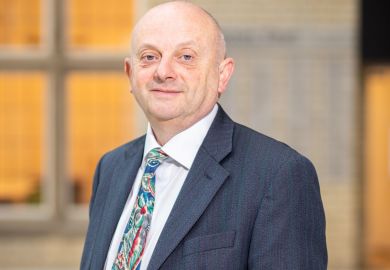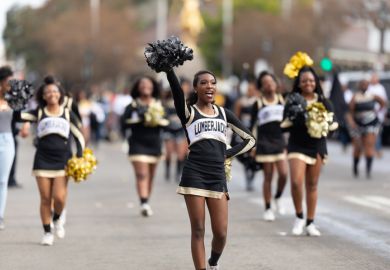A rare breed among university leaders, Kerstin Mey does not have a background in the hard sciences or even the humanities, but in the arts. The German academic and current University of Limerick president did her PhD in art theory and aesthetics – which becomes evident as she makes a point about rejigging the education system.
Her hands make a vertical line and then a horizontal line, illustrating the vertical business model, where different departments exist independently, interacting little with each other. She then contrasts this with a more horizontal system, where departments – and her hands – criss-cross one another.
But Mey’s background comes through on a far deeper level too, in her reimagining of the design of education itself. Her vision is to create spaces where “different disciplines can meet and grapple with each other,” she says. The “significant physical distance between buildings” within an institution does not suit her; it is telling of the strong boundaries in education.
“Unless you change the spatial organisation of your buildings to enable people to have chance encounters, sit together and informally have a coffee or tea...you make it much more difficult to develop ventures across our boundaries of disciplines and of institutional silos,” she says.
Mey looks to the visual arts as a source of inspiration, noting the discipline served in the early 20th century to create “contact zones” where different knowledge domains flourished together. She’s always valued what she calls “trans-disciplinary encounters”.
Back when she worked at the University of Westminster as pro-vice-chancellor and dean of the Westminster School of Media, Arts and Design from 2013 to 2018, she pushed for the idea in a “radical way”, scrapping disciplines altogether.
“I basically took out the departments and created an undergraduate level and a postgraduate level,” she says.
Suddenly, programmes such as commercial music could be paired with graphic design, animation with new media design. The different subjects within fashion education – fashion business, fashion design, fashion merchandising – were also unified, allowing students to move fluidly between them. This new “configuration” meant that students had a week within each semester where all areas offered “interesting and quirky exploratory sessions”. Students in music could dabble in the arts, journalism or food, for example. Faculty were also encouraged to engage with areas in which they wouldn’t typically work, as a way to stimulate ideas.
The changes, though, were short lived. When Mey eventually left the London institution, a more conventional set-up was reinstated, she says, because the media, arts and design department was alone in making the changes and it became hard to coordinate with the rest of the university.
Now at Limerick, which she has led since 2020, she has pushed for university-wide structural changes. The first of these has been to create a cross-disciplinary sustainability strategy. In her foreword to the policy, she writes: “The more we learn about the challenges of our time, the more we come to understand that they are systemic. They are interconnected and related in ways that can seem invisible to us.”
In response, Limerick has created 21 mission labs that target different elements of their sustainability strategy, with each lab bringing together expertise across relevant disciplines.
The biodiversity mission lab, for example, is working towards increasing the levels of biodiversity on campus. But it’s not just biologists who put their heads together here. Geographers, along with staff from the campus building and estates team, the team of gardeners and the student’s photography society, are all taking part, Mey says.
Over the last few years, Mey has also created new majors at the Irish institution, such as the “immersive software engineering” degree, where students are taught right through the bachelor’s to the master’s level. The course is intensive, involving classroom work towards 41 credits in addition to five 12-week residencies with different industry partners. Students embed in a variety of partners, from civil organisations, businesses to science and technology.
“I think that is a kind of prototype for a type of education that we are focusing on, where we provide the extended opportunities for students to work on real-life projects, co-designed and co-delivered with industry, government or civil society,” says the vice-chancellor.
In arts too, Limerick is advancing, Mey says, citing its dance degree – the only such degree in Ireland, which also includes aerial dance.
None of these programmes is “static”, she stresses, noting constant improvement. The next thing on her agenda is to broaden programmes in the humanities and connect them with other knowledge systems and applications in professional life.
As she reflects on her tenure as president, she remembers that she didn’t actually set out to lead a university but to curate art.
“I suppose my pathway to becoming the vice-chancellor or president has been marked by taking on leadership functions,” she says, adding that one thing led to another, starting from her first senior lecturer role at the University of Dundee’s Duncan of Jordanstone College of Art and Design.
Historically, it hasn’t been easy for university leaders to rise from these domains. More recently, in the UK, the University of Bristol’s Evelyn Welch and Michael Spence at University College London have bucked this trend with their arts and humanities backgrounds.
The rarity of this, Mey thinks, is possibly because the arts and humanities are “less opulently funded” compared with the hard sciences. An important factor in rising to university leadership is the ability to bring in research income as well as successful PhD completions, she says. PhD students in the arts and humanities are often self-funded, making it harder to meet this leadership criterion.
Another requirement for university heads is an extensive network of links, both within the education landscape and with industry, civil society organisations and government departments, she says. Again, the policy focus of governments is often more geared towards science and technology, according to Mey, making it harder for academics outside the fold to make it in.
Although leaders from these traditional backgrounds are seen to be “better equipped” historically, Mey says, there are big advantages to being a leader from the arts and humanities.
She emphasises that university education is currently “a child of the 20th century”. But times have changed rapidly. The arts and humanities are urgently needed to rethink education, she argues.
These disciplines, she says, have “an absolute value in their own right” to tackle questions of what it means to be human today, including how science and technology can be applied in an ethical way and how social justice can be achieved.
She underscores the strength of the interdisciplinary approach. “It’s not about a one-woman vision. It’s about bringing the collective insights and imagination together to think about ways forward.”
tiya.alexander@timeshighereducation.com
This is part of our “Talking leadership” series with the people running the world’s top universities about how they solve common strategic issues and implement change. Follow the series here.
Register to continue
Why register?
- Registration is free and only takes a moment
- Once registered, you can read 3 articles a month
- Sign up for our newsletter
Subscribe
Or subscribe for unlimited access to:
- Unlimited access to news, views, insights & reviews
- Digital editions
- Digital access to THE’s university and college rankings analysis
Already registered or a current subscriber?








